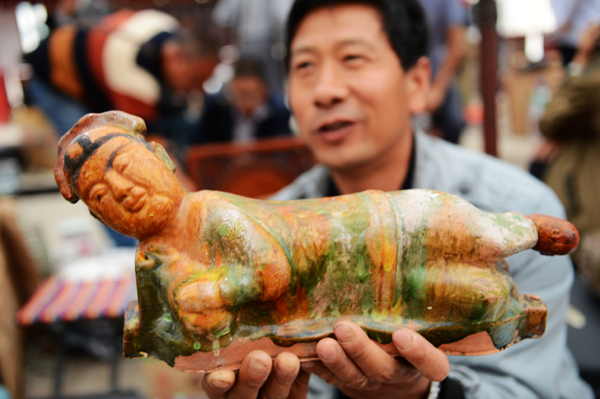Antique stores play unique role in saving the country's relics
By Zhao Xu ( China Daily ) Updated: 2015-05-16 07:30:02
 |
|
An antique trader from Henan sells a porcelain pillow. [Photo by Xiang Mingchao/For China Daily] |
The goods remained in the antique stores until the end of the 1970s, when the government started to restore the reputations of many people who were persecuted during the "cultural revolution", and return their confiscated assets. "Through the entire 1980s and into the early 1990s, our store had been engaged in the return of antiques to their formers owners, based on the registrations kept by the Red Guards nearly two decades before."
If records had been lost, owners could also make their own claims. "People back then were so honest, there were very few false claims." Li says.
It was during this time that the sale of antiques to people from Hong Kong and Taiwan and elsewhere was re-instated. "The practice was first introduced in the 1950, as the officially delineated role for State-owned antique stores at the time was to firstly collect State-level antiques for museums and secondly, sell the less-important ones for foreign exchange," says Xu, from the Henan store. "This was discontinued during the "cultural revolution", when China cut off almost all ties with the outside world. Such activities resumed in high spirit in the 70s and reached a peak in the mid-1980s."
What seems downright absurd today is the fact that more often than not, the antiques were sold not as individual pieces with their own varying historic and artistic value, but in bundles and bags.
Asked whether there was a realization among those working at the stores that they were underselling valuable, or even invaluable things, Xu says "No!".
"The price, a tiny fraction of what the pieces command now, was actually quite high compared to our monthly salary of a couple dozen yuan, or a few US dollars," he says. "As far as I'm concerned, the biggest mistake we made at the time was to allow large number of antiques to go through the Chinese customs. Many of what we then categorized as second-rate and salable turned out to be much rarer or precious than first thought."
Despite the price, Xu says he would like to save money and buy something for himself if it was allowed. "According to the country's Law On The Protection Of Cultural Relics, people working at State-owned antique stores were forbidden to buy or trade in antiques," he says. "As a result, none of us dared to."
The law is still in place today, although people like Xu and Li no longer feel bound by it. "With China embracing the market economy in the early 1990s, everything changed. The government publicly announced its intention to 'entrust our cultural treasures with the people', which was immediately interpreted as allowing more freedom among its citizens to trade antiques," Xu says.
For the next decade, China's antique market flourished, giving birth not only to countless antique malls and open-air bazaars, but also to the darker world of tomb raiding and antique trafficking. Meanwhile, the government has sought to re-evaluate its former antique export policy. Large quantities of antiques previously under the charge of State-owned export companies were transferred to antiques stores, where they had their value reappraised by experts. "Control over the exportation of antiques was considerably tightened," says Li, from the Tianjin store. "The era when Chinese antiques were bought up by the richer parts of the world was gone once and for all, and Chinese were to take the lead in the purchasing of their own cultural treasures."
|
|
|
|
|
|
|
|

























 Raymond Zhou:
Raymond Zhou: Pauline D Loh:
Pauline D Loh: Hot Pot
Hot Pot Eco China
Eco China China Dream
China Dream China Face
China Face






